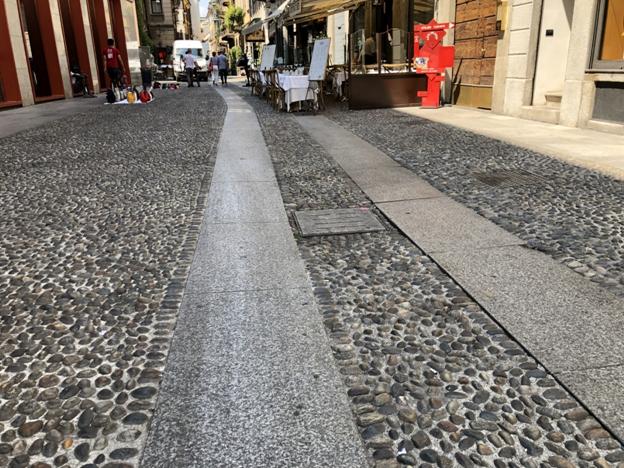Disabled Access Review of Milan
By John Sage
 The global capital of fashion and design, Milian, is located in Italy’s northern Lombardy region. Peppered with high-end restaurants and shops, this bustling city is a wonderful addition to any Italian itinerary. Milan is the home of the Gothic Duomo di Milano cathedral, the Santa Maria delle Grazie convent and Leonard da Vinci’s mural “the Last Supper.
The global capital of fashion and design, Milian, is located in Italy’s northern Lombardy region. Peppered with high-end restaurants and shops, this bustling city is a wonderful addition to any Italian itinerary. Milan is the home of the Gothic Duomo di Milano cathedral, the Santa Maria delle Grazie convent and Leonard da Vinci’s mural “the Last Supper.
Wheelchair access in many old Italian cities can be challenging. In Milan, the cobblestones that you’ll find in certain areas, as well as the lack of curb cuts and accessible transportation, means that planning before your visit is key. You’ll want to avoid these during your visit. In the city center, the overall flatness is great, making it possible to roll/walk between the most popular sights.
Best Aspects of Milan Disabled Access
Flat terrain – Although the Alps are not far away, the city center of Milan is fairly flat. There are a few hills in certaun places, but if you stay in the right, centrally located neighborhood, you won’t encounter them.

Ramp at The Last Supper – Leonardo da Vinci’s famousLast Supper fresco can be found inside the Santa Maria delle Grazie renaissance church. It has a wheelchair ramp to enter the building (shown below).

Elevator at Brera Art Gallery – The Brera Art Gallery is a world-class art collection and includes works by Raphael, Bramante, Tintoretto, Caravaggio, Rubens, and van Dyck. Be sure you don’t miss the Lamentation of Christ by Mantegna! The Brera Art Gallery has an elevator to get to the upper floor where the artwork is housed. The elevator is quite hidden. If you walk/roll from the main entrance and through the courtyard (shown below), turn left down the hall then the elevator can be found at the end of the hall on the left.

Step-free entrance into Galleria Vittorio Emanuele II – The Galleria Vittorio Emanuele II (shown below) is located next to the Duomo Cathedral. It has four entrances and all of them are step-free. The only challenge will be that you need to find one of the sidewalk ramps to get up from street level.

Several attractions within walking/rolling distance of each other–Depending on your abilities and energy level, it may be possible for you to walk/roll between attractions. For example, Duomo to Galleria to Brera Art Gallery is only 1 km (0.6 miles).

Easy train connections – Milan has three main train stations (Zazione Cadorna, Milano Porta Garibaldi, and Milano Centrale). They have flat access (examples shown below) and wheelchair lifts to get on the train. These train stations provide easy connections to Venice, Verona, Florence, Interlaken, or Rome. Be sure to book the wheelchair lift assistance in advance…we include the reservations as part of our Milan accessible travel packages).



Most Challenging Aspects of Milan Disabled Access
Cobblestone abundance – In Milan, cobblestones can be found on many streets and crosswalks (examples shown below). Wheelchair users and other travelers with disabilities should take care when walking/rolling over the cobblestones.

Missing sidewalk ramps – Some sidewalks, especially near tram tracks, don’t have sidewalk ramps at the crosswalks (example shown below).

Tram tracks – Many tram tracks are present in the streets of central Milan. Wheelchair users should be careful when rolling over the train tracks.
Tram accessibility – The vast majority of trams have steps to enter them (example shown below). If disabled travelers want to use them, they should confirm that the tram stations and the tram itself are accessible for the route they want to use.

Metro accessibility – While many train stations outside the city center have elevators, those stations are not really helpful for tourists. Inside the city center, many train stations do not have elevators. Disabled travelers should also be prepared for a scenario where they take the metro, then the station where they are supposed to get off has an elevator that is out of service. If that is a problem and you can’t develop a back-up plan (like riding an escalator), then you should probably skip using the Metro.
Many attractions are separated by long distances – The top two attractions in Milan are the Duomo Cathedral and the Last Supper. They are separated by 1.8 km (1.1 miles) which may work for mobility scooter users but be tiring for manual wheelchair users.

Narrow pathway on Duomo roof – While an elevator leads up to the Duomo roof, the pathway is quite narrow and some wheelchair users may not be able to fit (I fit…but just barely).

Both train stations are not in the city center – Milan’s two main train stations are the Milano Porta Garibaldi and the Milano Centrale Station. Both are located far enough away that most disabled travelers will not want to walk/roll to their hotel especially if they have luggage.
Reservations needed months in advance for Last Supper – In order to preserve the Last Supper, entrance is regulated, extremely limited, and only by guided tour. Be sure to book your accessible Last Supper tour at least a few months in advance.
Want a 100% Accessible Vacation?
View our Milan Accessible Travel Packages


